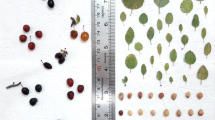Abstract
Round gourd (Praecitrullus fistulosus (Stocks) Pangalo), generally familiar as Indian round gourd, apple gourd and Indian baby pumpkin, is a squash type cucurbit, cultivated for its immature fruit, a vegetable notably trendy in South Asia. This rare squash type gourd is native to India. For carrying out this research, 25 round gourd accessions were obtained from National Agricultural Research Centre (NARC), Islamabad, Pakistan, for estimation of their morphological variations on the basis of different vegetative and reproductive attributes. Multivariate analysis of variance (Principal component analysis and Cluster analysis) was performed for grouping round gourd accessions on the basis of similarities in morphological parameters of leaves, vine, flowers and fruits using XLSTAT (2017). One way analysis of variance (ANOVA) was practiced for statistical analysis and significant variations between means were recorded by Duncan’s multiple range (DMR) test at P < 5% for quantitative data of morphological characters. Morphological variation was most apparent in leaf size, leaf color, fruit shape and fruit skin color. Accession 20399 was morphologically very close to other accessions except for its cordate leaf shape whereas rest of the accessions had lobed leaves. Results of the principle component analysis for quantitative morphological traits indicated that the first two PCs explained 32.21% and 14.91% (a total of 47.12%) of the total variation. Cluster analysis grouped all round gourd accessions of Pakistan into two main clusters with 61.65% variability within class and 38.35% diversity between classes. The work presented here is the first report about morphological characterization of Pakistani P. fistulosus germplasm.




Similar content being viewed by others
References
Bajracharya J, Steele KA, Jarvis DI, Sthapit BR, Witcombe JR (2006) Rice landrace diversity in Nepal: Variability of agro-morphological traits and SSR markers in landraces from a high altitude site. Field Crops Res 95:327–335. https://doi.org/10.1016/j.fcr.2005.04.014
Bajwa ML, Rehman F (1998) Vegetables and their fertilizer management. Agriculture, environment, forestry and fertilizer company (Pvt) Ltd, Lahore, p 93
Baloch AF (1994) Vegetable crops. Horticulture. National Book Foundation, Islamabad, pp 489–538
Bisognin DA (2002) Origin and evolution of cultivated cucurbits. Cienc Rural 32(5):715–723. https://doi.org/10.1590/S0103-84782002000400028
Demol J, Baudoin JP, Louant BP, Marechal R, Mergeai G, Otoul E (2001) Plant breeding: application to the main species grown in tropical regions. Ed presses of Gembloux, Gembloux, p 583
Gurleen KS, Pathak M (2016) Genetic diversity analysis in bitter gourd (Momordica charantia L.) using morphological traits. Int J Agric Innov Res 5(1):59–63
Kocyan A, Zhang LB, Schaefer H, Renner SS (2007) A multilocus chloroplast phylogeny for the Cucurbitaceae and its implications for character evolution and classification. Mol Phylogenet Evol 44:553–577. https://doi.org/10.1016/j.ympev.2006.12.022
Levi A, Thomas CE, Simmons AM, Thies JA (2005) Analysis based on RAPD and SSR markers reveals closer similarities among citrullus and cucumis species than with Praecitrullus fistulosus (Stocks) Pangalo. Genet Resour Crop Evol 52:463–470. https://doi.org/10.1007/s10722-005-2260-2
Levi A, Wechter P, Davis A (2008) EST-PCR markers representing watermelon fruit genes are polymorphic among watermelon heirloom cultivars sharing a narrow genetic base. Plant Genet Res 7:16–32. https://doi.org/10.1017/S1479262108014366
Levi A, Harris KR, Wechter WP (2010) DNA markers and pollen morphology reveal that Praecitrullus fistulosus is more closely related to Benincasa hispida than to Citrullus spp. Genet Resour Crop Evol 57:1191–1205. https://doi.org/10.1007/s10722-010-9559-3
Lloyd A, Walbot V, Davis RW (1992) Arabidopsis and Nicotiana anthocyanin production activated by maize regulators R and C1. Science 258:1773–1775
Marr KL, Xia Y, Bhattarai NK (2007) Allozymic, morphological, phenological, linguistic, plant use, and nutritional data of Benincasa hispida (Cucurbitaceae). Econ Bot 61:44–59. https://doi.org/10.1663/0013-0001(2007)61%5b44:AMPLPU%5d2.0.CO;2
Ndour D (1998) Tests of Agro-morphological characterization and genetics of salt tolerance in rice (Oryza sativa L.) in the Senegal River Delta. Memory Master II, University Cheikh Anta Diop in Dakar, pp 1–27
Pangalo KI (1944) A new genus of the Cucurbitaceae. Praecitrullus, an ancestor of the contemporary watermelon (Citrullus Forsk.). Bot Zurr SSSR 29:200–204
Panigrahi I, Duhan DS (2018) Study of variability and morphological characterization of cultivated genotypes of bottle gourd [Lagenaria siceraria (Mol.) Stdl.]. Int J Chem Stud 6(1):1863–1866
Querol D (1987) Genetic resources—a practical guide to their conservation, vol 52. Zed Books Ltd, London, p 55
Rahman ASH (2003) Bottle gourd (Lagenaria siceraria) a vegetable for good health. Nat Prod Radiance 2(5):249–250
Schaefer H, Renner SS (2011) Cucurbitaceae. In: Kubitzki K (ed) Families and genera of flowering plants, vol 10. Springer, Berlin, pp 112–174
Schaefer H, Heibl C, Renner SS (2009) Gourds afloat: a dated phylogeny reveals an Asian origin of the gourd family (Cucurbitaceae) and numerous oversea dispersal events. Proc Biol Sci 276:843–851. https://doi.org/10.1098/rspb.2008.1447
Srivastava U, Mahajan RK, Gangopadhyay KK, Mahendra S, Dhillon BS (2001) Minimal descriptors of agri-horticultural crops. Part II: vegetable crops. National Bureau of Plant Genetic Resources, Pusa Campus, New Delhi, p 9
Sujatha VS, Seshadri VS (1989) Taxonomic position of round melon (Praecitrullus fistulosus). Cucurbit Genet Crop Rep 12:86–88
Tindall HD (1985) Vegetable in the tropics. Macmillan Press Ltd, London, p 152
Tyagi N, Sharma GN, Hooda V (2012) Medicinal value of Praecitrullus fistulosus: an overview. Int J Pharm Therap 3(2):136–142
Wehner TC, Shetty NV, Elmstrom GW (2001) Breeding and seed production. In: Maynard DN (ed) Round gourds: characteristics, production, and marketing. ASHS Press, Alexandria, pp 27–73
XLSTAT (2017) XLSTAT version 5.5. Paris: Addinsoft 2017.5. info@xlstat.com
Acknowledgements
We gratefully acknowledge National Agricultural Research Centre (NARC), Islamabad, Pakistan for providing us with valuable germplasm for conducting this study.
Author information
Authors and Affiliations
Corresponding author
Ethics declarations
Conflict of interest
The authors declare that they have no conflict of interest.
Rights and permissions
About this article
Cite this article
Shahid, A., Ayyub, C.M., Abbas, M. et al. Assessment of genetic diversity in round gourd (Praecitrullus fistulosus) germplasm of Pakistan considering morphological characters. Genet Resour Crop Evol 66, 215–224 (2019). https://doi.org/10.1007/s10722-018-0707-5
Received:
Accepted:
Published:
Issue Date:
DOI: https://doi.org/10.1007/s10722-018-0707-5




